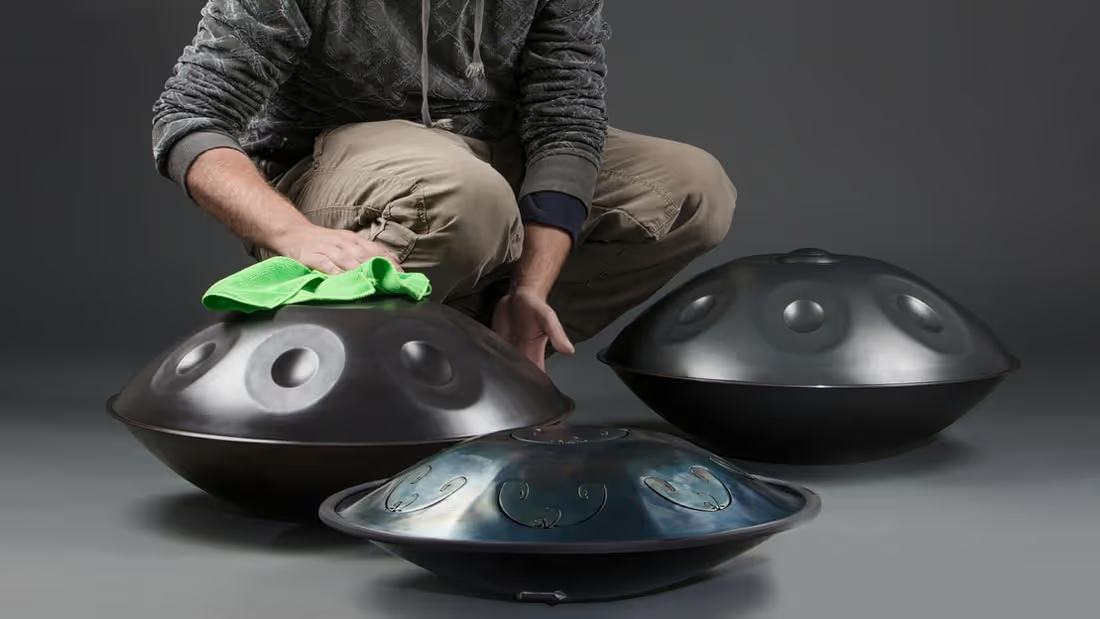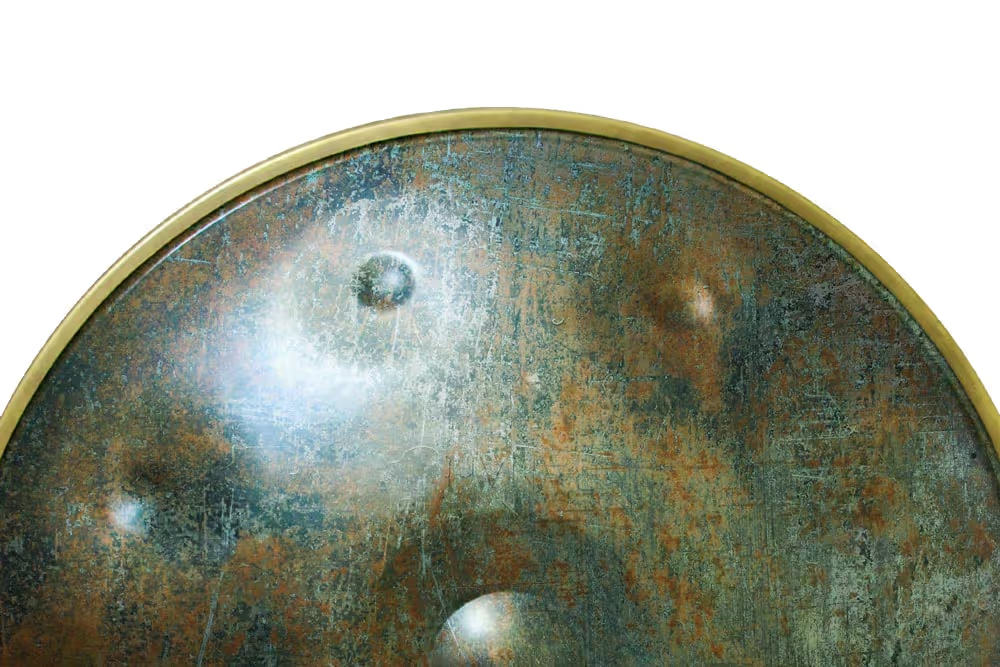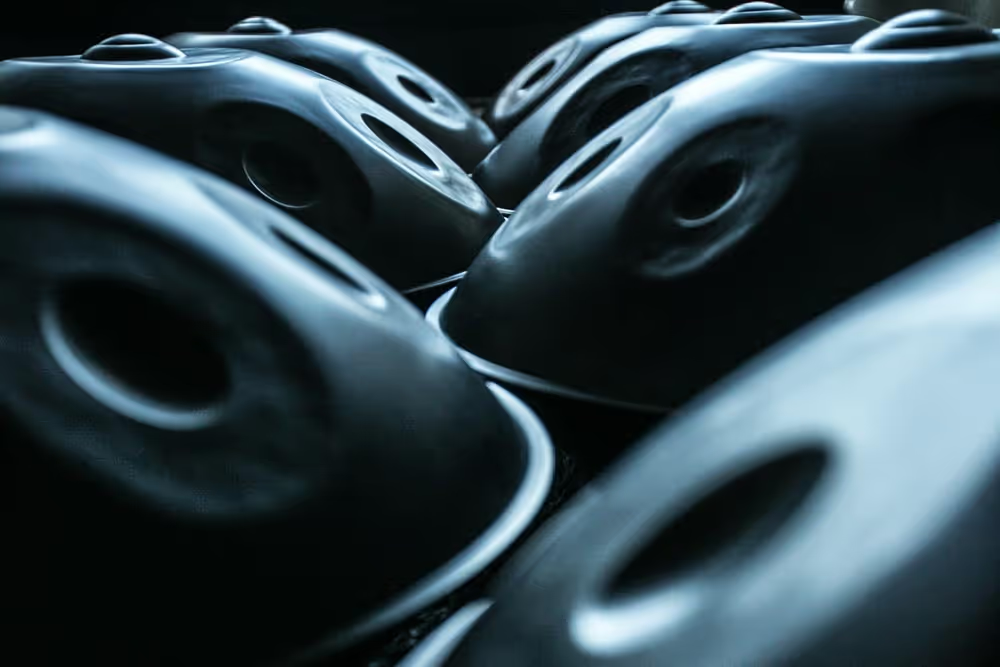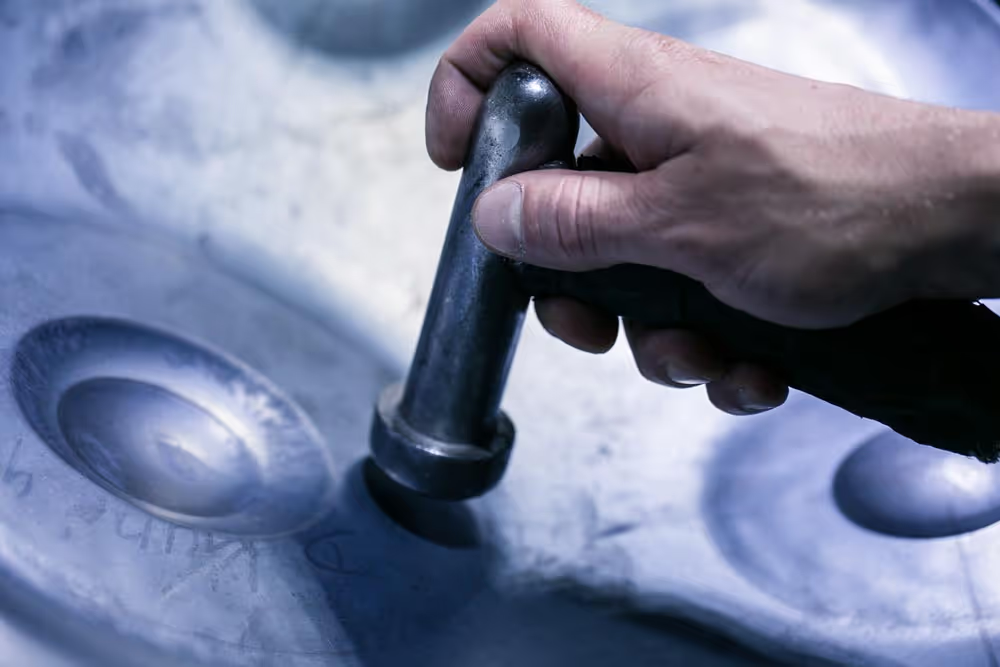I’m worried about rust, I’m worried I might drop it or store it wrong and I’m very worried that my dog is looking at it like it’s a new toy. What should I do? Ah, yes, these precious instruments require certain Dos and Don’ts. But the good news is they can stay like new with proper thought and care. And the even better news is I’ve written how to do this in this guide.
Well-built handpans are actually tougher than you think. Afterall, they are made from treated steel, not butterfly wings. I’ve dropped mine into cases too quickly, bumped and knocked them, played them hard, taken them to humid countries and beaches, and used them to perform in open-air concerts in cold mid-winter… and they have all survived brilliantly.
Spyros Pan, a great player from Greece, even fully submerged his Halo in a swimming pool for two hours for a photoshoot! He dried it thoroughly with just a regular microfibre cloth and, 6 years later, it still doesn’t have a single spot of rust on it.
While I wouldn’t recommend you use yours as a frisbee or take it for a swim with dolphins, with knowledge and some careful maintenance, it should stand the test of time.
General Dos and Don’ts
Never, ever, let someone play your handpan whilst wearing metal rings or bracelets, long necklaces/pendants or exposed metal belt buckles. The smallest scratch can have the biggest consequences.
Every time your handpan is played (by you or others), wipe it down with a microfibre cloth on both sides. Don’t forget the inside needs love sometimes too.
Dryness is a virtue: Never put your pan into a bag whilst damp; and never put your pan into a damp bag. Have a regular cleaning routine, especially if you live near to the sea or in humid conditions.
See here for a simple, fun pictorial guide to keeping your handpan looking good and avoiding those dreaded brown spots.
Storage at home
Your handpan needs to breathe, so do not leave it in a closed bag or case for long periods. (The exception is if you live very close to the sea/salt air, then put it into an airtight hardcase or cabinet with a moisture eater, but make sure both the container and the pan are 100% dry first, or the rust process will accelerate).
Don’t store it too close to a source of heat, like a fire or radiator.
Never place it upside down. Any prolonged pressure can de-tune the Ding. If you really have to (for example when you clean it), use a blanket, a beanbag or something thick and soft.
That said, there are many ways to keep it safe - on a wall with a handpan hook attachment (I recommend the HCT wall hanger and the wall mount by Artful Steel), a specially designed handpan rack, or on a stand away from potential knocks. I’m trialling some of the best stands – watch out for my coming reviews.
For more makeshift alternatives, Ikea have some great shelves that fit. If you have a beanbag, these are great as they mould to your pan to keep it safe (best not to do this if you have kids or dogs who might try to sit on it!).
A simple option is to place it on a sturdy table with a cloth underneath.
If you knit, crochet or are generally crafty, you can make your own handpan mat, which can be used for both storage and for play. A friend of a friend of mine makes these out of recycled strips of clothing and they work brilliantly.

Whenever you carry your handpan, either hold it firmly inside the Gu or preferably transport it in its case. Go slowly and look a few paces ahead to see if there are any trip/knock hazards.
At all times, be careful of children and animals… and clumsy adults 😅
The big, scary outside world
Wherever you travel, a solid, reliable bag is the key to keeping your beloved handpan safe. I recommend Evatek (which I personally use), Namana and Panji bags. If you’re just going somewhere local/far from the madding crowds, a padded soft bag should be fine, but otherwise, it’s best to have a hardcase.
Planes and handpans are not naturally the best of friends, but I’ve flown safely with them many times all over the world. Here’s my essential guide "Everything you need to know about flying".
To add an extra layer of protection, give your handpan a quick splash of Phoenix oil before leaving the house.
Nature can really mess things up. But we cannot let that stop us from having fun, magical times with our handpans. I’ve written an in-depth article on Heat and Cold but in a nutshell, the 4 elements you need to watch out for;
🌿 Earth
If you have to place your handpan temporarily on the ground, run your eyes and fingers over the space first to make sure that it is free from pebbles, sharp pieces of wood, bits of glass or anything else that may scratch or dent the Gu side. Use a handpan mat (see above) or place it on an item of clothing or a rug. If the earth/grass is damp, use a waterproof mat, coat or plastic bag.
That said, it’s ALWAYS better to pop it back in its case rather than on the ground.
💨 Air
Humidity is the killer! So go mad with a microfibre cloth to keep your pan dry. In itself, the cold isn’t harmful but it can temporarily affect the tuning until it gets back to normal temperatures again. If it is exceptionally cold, damp or you want to play in the snow (who doesn’t?!), make sure you dry it thoroughly afterwards with your trusty cloth.
🔥 Fire
If you accidentally leave your handpan in the sun (ouch!), move it to the shade and wait until it cools down before playing it again. The heat expands the metal and affects its tension, so playing while hot could permanently affect its tuning.
💧 Water
While it’s beautiful to play in the rain, or on the surface of a lake, water is the potential enemy of our instruments. Keep your bag closed and dry at all times. After playing, thoroughly wipe both sides and the inside with a microfibre cloth (or two). If your handpan has a foam or fabric rim-protector, ensure this is also dry before putting it back on. Then check your bag is as arid as a camel’s throat before putting your pan back inside.
🏖️ All of the above at once
The beach is possibly the most romantic place to be with your handpan. Seeing the sun set on the horizon, feeling the sea breeze ruffle your hair, hearing the ocean waves gently lap as you play – it is like being in a movie scene, with your pan as the soundtrack. However, I’m sorry to say it’s possibly the worse environment for your handpan! The salty sea air, the humidity, the hot sun, the gritty grains of sand that get everywhere… it’s like all your enemies have shown up at once.
The most crucial thing here is to ensure your bag stays dry, so don’t open it/expose it to the salty, damp air for more than a few seconds. Dry your pan thoroughly as before. Wipe it over more than once if you stay for any length of time. When you get home, give it a clean with alcohol to remove any salt or sand residue. And make sure you wash your cloth too.
That’s it. If you follow everything above, you should have a shiny, beautiful, tuneful handpan for a long time to come.














